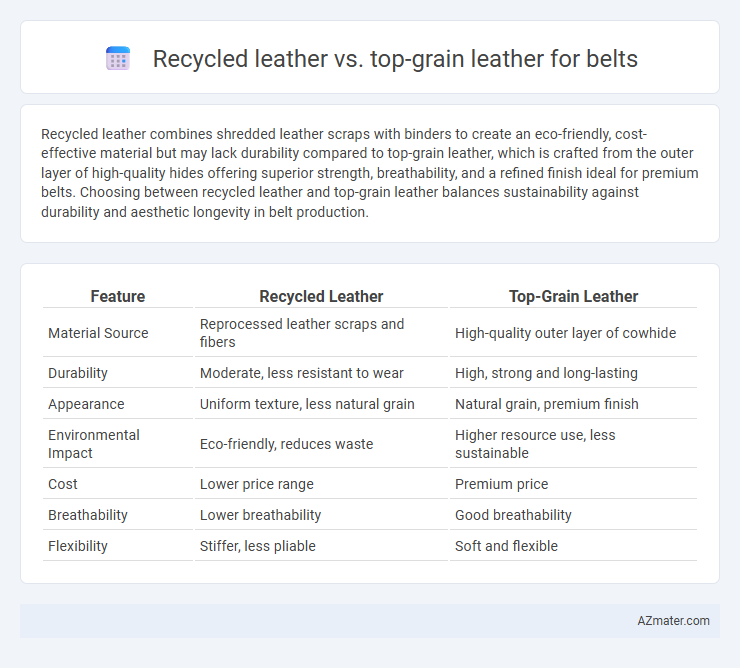Recycled leather combines shredded leather scraps with binders to create an eco-friendly, cost-effective material but may lack durability compared to top-grain leather, which is crafted from the outer layer of high-quality hides offering superior strength, breathability, and a refined finish ideal for premium belts. Choosing between recycled leather and top-grain leather balances sustainability against durability and aesthetic longevity in belt production.
Table of Comparison
| Feature | Recycled Leather | Top-Grain Leather |
|---|---|---|
| Material Source | Reprocessed leather scraps and fibers | High-quality outer layer of cowhide |
| Durability | Moderate, less resistant to wear | High, strong and long-lasting |
| Appearance | Uniform texture, less natural grain | Natural grain, premium finish |
| Environmental Impact | Eco-friendly, reduces waste | Higher resource use, less sustainable |
| Cost | Lower price range | Premium price |
| Breathability | Lower breathability | Good breathability |
| Flexibility | Stiffer, less pliable | Soft and flexible |
Introduction to Recycled Leather and Top-Grain Leather
Recycled leather is made by shredding and re-bonding leftover leather scraps, offering an eco-friendly alternative that reduces waste while maintaining a leather-like appearance. Top-grain leather, on the other hand, comes from the upper layer of the hide, prized for its durability, natural grain, and refined finish that develops a rich patina over time. Both materials serve different needs in belt crafting, with recycled leather appealing to sustainable fashion and top-grain leather favored for premium quality and longevity.
What is Recycled Leather?
Recycled leather, made from shredded scrap leather fibers bonded with polyurethane or latex, offers an eco-friendly alternative to traditional leather. Top-grain leather, sourced from the upper layer of the hide, provides superior durability and natural texture but has a higher environmental impact. Choosing recycled leather belts reduces waste and supports sustainable fashion practices while maintaining a leather-like appearance.
What is Top-Grain Leather?
Top-grain leather is the second-highest quality leather made by sanding the natural grain off the hide to eliminate imperfections, resulting in a smooth and durable surface ideal for belts. It offers excellent strength, breathability, and the ability to develop a rich patina over time, enhancing the belt's aesthetic appeal. Unlike recycled leather, which is made from shredded leather fibers bonded with additives, top-grain leather maintains the hide's original structural integrity and longevity.
Production Process Comparison
Recycled leather belts are made by shredding leather scraps mixed with a bonding resin, which are then compressed into sheets to form the material, offering an eco-friendly alternative with less waste. Top-grain leather belts are crafted from the upper layer of cowhide, where the surface is sanded and refinished to remove imperfections, resulting in durable and high-quality leather. The production of recycled leather is more sustainable but less durable than top-grain leather, which requires a more labor-intensive tanning and finishing process.
Durability and Longevity
Top-grain leather belts offer superior durability and longevity due to their dense fiber structure and natural resistance to wear and tear. Recycled leather, made from shredded leather scraps bonded with synthetic materials, tends to have less durability and may deteriorate faster under constant use. Investing in top-grain leather belts ensures longer-lasting strength and maintains aesthetic quality over time compared to recycled leather alternatives.
Environmental Impact and Sustainability
Recycled leather production minimizes waste by repurposing leftover leather scraps, reducing landfill use and conserving resources compared to top-grain leather, which requires more raw materials and involves intensive tanning processes. The environmental footprint of top-grain leather includes higher water consumption, chemical pollution, and greenhouse gas emissions, whereas recycled leather offers a sustainable alternative with lower energy demands and reduced environmental hazards. Choosing recycled leather belts supports circular economy principles by extending material life cycles and decreasing the fashion industry's overall ecological impact.
Aesthetic and Texture Differences
Recycled leather belts showcase a unique, consistent texture with a slightly synthetic feel due to the blending of leather scraps, offering a range of colors and patterns not typically found in natural leather. Top-grain leather belts feature a smooth, supple surface with natural grain patterns and subtle imperfections that enhance their rich, classic aesthetic and provide a luxurious, soft-to-the-touch texture. The durability of top-grain leather allows it to develop a distinctive patina over time, while recycled leather maintains its original appearance without significant aging or character changes.
Cost and Value Analysis
Recycled leather belts offer a cost-effective alternative, typically priced 30-50% lower than top-grain leather belts due to the use of scrap materials bonded with synthetic adhesives. Top-grain leather belts provide superior durability and natural texture, justifying their higher price point with long-lasting wear and premium aesthetic appeal. Consumers seeking budget-friendly options prioritize recycled leather for affordability, while those valuing longevity and authentic leather quality invest in top-grain leather belts for better overall value.
Maintenance and Care Requirements
Recycled leather belts require less intensive maintenance compared to top-grain leather, as their surface is often coated to resist stains and moisture, reducing the need for frequent conditioning. Top-grain leather belts demand regular application of leather conditioners and protective creams to maintain suppleness and prevent cracking, especially when exposed to sweat or humidity. Proper storage in a cool, dry place and avoiding prolonged exposure to direct sunlight are essential for both materials to extend belt longevity.
Which Leather is Best for Belts?
Top-grain leather is widely regarded as the best choice for belts due to its durability, natural texture, and ability to develop a rich patina over time, making it both strong and aesthetically appealing. Recycled leather, made from shredded leather fibers bonded with synthetic materials, tends to be less durable and may not age as gracefully, but offers an eco-friendly alternative at a lower cost. For long-lasting quality and resilience, top-grain leather belts outperform recycled leather counterparts in wear resistance and visual appeal.

Infographic: Recycled leather vs Top-grain leather for Belt
 azmater.com
azmater.com